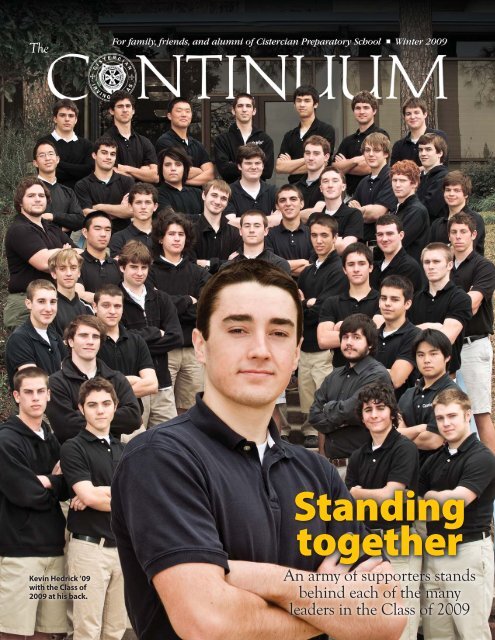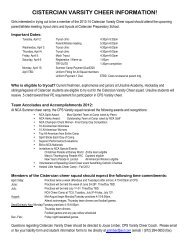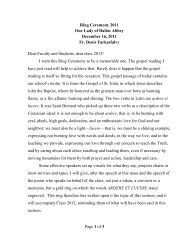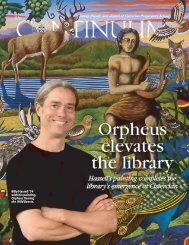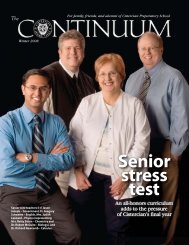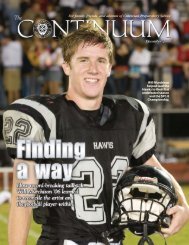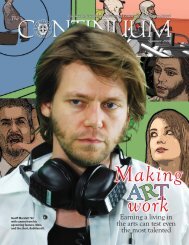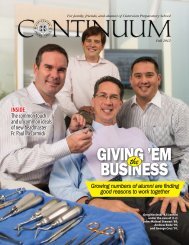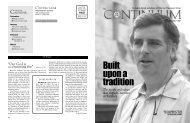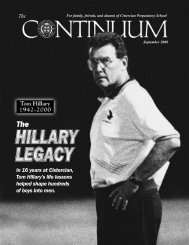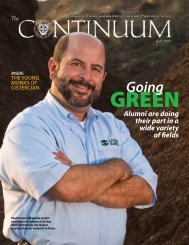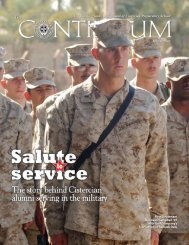Winter 09 Continuum FINAL.indd - Cistercian Preparatory School
Winter 09 Continuum FINAL.indd - Cistercian Preparatory School
Winter 09 Continuum FINAL.indd - Cistercian Preparatory School
- No tags were found...
Create successful ePaper yourself
Turn your PDF publications into a flip-book with our unique Google optimized e-Paper software.
The Memorare Society was established for members of our communitywho wish to include <strong>Cistercian</strong> in their financial plans through bequests,trusts, wills, or other means. It’s a wonderful way for peopleto include the school as part of their long-term financial planning.As a member of the Memorare Society, you’ll enable us to continueeducating <strong>Cistercian</strong> students and the Abbey’s young monksfor many years. All while ensuring your legacy with <strong>Cistercian</strong>for generations to come. After all, Memorare means “remember.”To find out if the Memorare Society is right for you and your family,simply contact Carolina Pruit in the Development Office today.All enquiries are welcome. Call 469-499-5422, or send an emailto cpruit@cistercian.org.
trips; but, he earned his stripes with headmasters by his willingnessto take on any job.“I just got in the habit of telling them, ‘Yes, I can do that,’”Walter explained in his remarks, in which the 43-year veteran ofthe school demonstrated the kindness he has shown throughouthis career.“I can think of no better words for the <strong>Cistercian</strong> communitythan ‘Thank you from the bottom of my heart.’” he concluded.Dr. Tom Pruit introduced the Moroney Award winner andinformed the audience that Parker was the first graduate of thenineties to win the coveted award. “I think Tim is the first redheadedbasketball coach with twins to win the award as well,” hejoked. “That should stand for a while.”While chiding him for his fashion sense (as teacher, tenniscoach, and director of facilities), Pruit quoted a parent who duringan Open House was “struck by his use of visual, auditory, andkinetic techniques, his expert use of questions and his calm butimpassioned manner, all signs of an excellent teacher.”In accepting the award, Parker first wanted to acknowledgethe appropriateness of being honored with Rodney Walter, hispredecessor as director of facilities.A few days after accepting the new position from Fr. Peter,Walter dropped by a 15-page hand-written job description.“The grin on his face screamed ‘sucker!’” Parker remarked.“I do [my job at <strong>Cistercian</strong>] because I love it,” he said.“I do it because the students amaze me everyday with theirhumor, their intelligence, their goodness, and even their insight.“I do it,” Parker concluded, “because after thirteen years of‘working here,’ I don’t feel like I have worked a single day.”Photos by Jim ReischHonoreesLeft: RodneyWalter with hishonorary diplomaat the MoroneyAward Dinneron January 30.Below: Tim Parkerabsorbs a standingovation afteraccepting theMoroney Award.Honor for faculty members welcomedParker suggests that many non-alumni teachers deserve honorsThe 20<strong>09</strong> Jim and Lynn Moroney Award Dinnerwill be remembered as a trend-setter.It was a night when the entire lay faculty was honoredby two of theirs winning the night’s spotlight andpraise.Parker made the point he was particularly happythat Rodney Walter was awarded an honorary <strong>Cistercian</strong>diploma.“Such an award is long overdue,” he said. “It allowsus the opportunity to award a faculty or staffwhether they’re an alum or not. Up to now there wasnot a formal way to do that.”“As glad as I am that Rodney won it,” hecontinued, “I am just ashappy that the precedenthas been set.“I won the MoroneyAward because I happento be an alum,” he emphasized,“but there is a list ofequally deserving facultymembers who are just asdeserving but didn’t graduatefrom <strong>Cistercian</strong>.”FAMILY SUPPORTAbove: Tim Parkerwith wife Amy,children Elizabeth,Will, and the twins,Kate and Emily. Bottom(l-r) Matt Walter’86, Rodney Walter,wife Libby, and RodWalter ’83.<strong>Winter</strong> 20<strong>09</strong> 7
GENERATION8 Photo courtesy of Abbot Denis FarkasfalvyThe <strong>Continuum</strong>
GAPByDavidE. StewartAge, personalities, andloyalties created differencesbetween Fr. Anselm Nagy andthe young <strong>Cistercian</strong>s whoescaped Hungary in 1956Editor’s note: This is the fourth in an occasional seriesof stories celebrating the <strong>Cistercian</strong>s’ 50 years in Texas.THE CAR CARRYING FR. ANSELMNagy turned off of Rome’s sunnyPiazza del Tempio di Diana androlled to a halt under the shade ofthe <strong>Cistercian</strong> Generalate’s frontgate house.By the time the 42-year-oldgrabbed his hat and coat and madehis way into the sunlit courtyardon this April afternoon in 1957, a group had hurried downfrom their rooms to greet the visitor from America.These young refugees of the October 1956 HungarianRevolution — including Br. Roch Kereszty, Br. MatthewKovacs, Br. Julius Lelóczky, and Br. Denis Farkasfalvy —were just the people Fr. Anselm had come to see.Officially, Fr. Anselm traveled from Dallas to attend ameeting of the <strong>Cistercian</strong> Order’s Definitorium that assembledannually among the blooms of the Roman spring. (Fr.Anselm was making his second appearance at the meetingsince being appointed in 1955 as the delegated superior overvirtually all of the displaced Hungarian <strong>Cistercian</strong>s.)But he primarily came to initiate a relationship with the1956 refugees. Since their escape from Hungary in November,they had become his responsibility and subject to hisauthority.While armed with few specifics, Fr. Anselm knew theyoung monks were studying for their doctorates in Theology.After they completed their studies and were ordained,he expected them to join his new community in Dallas.This fledgling foundation in Texas had been establishedin 1955 to provide a home for those <strong>Cistercian</strong>s forced toflee from Soviet-oppressed Hungary. Although this newhome lay in America, the expatriated <strong>Cistercian</strong>s werepledged to carry on their vocations as dictated by the Abbeyof Zirc (pronounced Zeertz), the mother abbey of allHungarian <strong>Cistercian</strong>s.The beautiful abbey and its vast operations had been shutdown by the Soviets by October 1950, forcing all religiousactivity underground.<strong>Winter</strong> 20<strong>09</strong>OUT WITH THE BOYS IN 1960 Fr. Anselm Nagy (withthe hat and coat), superior of the Our Lady of Dallasmonastery, walks in Rome with three young refugeesof the 1956 Revolution (left to right): Br. Roch Kereszty,Br. Denis Farkasfalvy, and Br. Julius Lelóczky.9
The two-year-old American incarnation of Zirc in Dallas mightstruggle, but the monks in Texas were determined to preserve the<strong>Cistercian</strong> Order’s 800-year-old Hungarian history. Fr. Anselm carriedthis responsibility with him wherever he went.By 1957, the odds of its long-term survival appeared unclear.On the one hand, the community in Dallas numbered 18, and wasexpected to grow as Hungarian <strong>Cistercian</strong>s continued to assemblethere.The University of Dallas, where nine <strong>Cistercian</strong>s comprised halfof the faculty, was nearing the completion of its first school year.And on March 30 (just weeks before this visit to Rome), constructionhad begun on the monastery near the university — the firstpermanent home for the Hungarian <strong>Cistercian</strong>s since leaving theirhomeland.Other signals suggested a less sanguine assessment.None of the <strong>Cistercian</strong>s teaching at UD had rated the title of professorin that first year, even those with doctorates and Americanteaching experience (e.g., Frs. Damian Szödényi, Ralph March, andLouis Lékai).University administrators also had relegated the monks to the bottomof the pay scale (where they would remain for two decades).Fr. Anselm’s negotiations on carving out a piece of land for the<strong>Cistercian</strong>s had progressed about as smoothly as a root canal. Onlywith the bishop’s intervention had the <strong>Cistercian</strong>s been able to pry34 acres — 19 of which lay in flood plain — away from the 1,000acres pledged to the university.While insignificant in the scheme of UD’s holdings, the 34 acreswould provide sufficient space to locate a secondary school adjacentto the monastery.But there was a catch.The university had not made full payment on their 1,000 acres,and so was unable to transfer title for the 34 acres. The <strong>Cistercian</strong>swould have to finance the construction of the monastery without theuse of the 34 acres as collateral.UPON GREETING FR. ANSELM IN THE COURTYARD, theyoung brothers eagerly drank in every detail of their new superior’sKISS OF PEACE Fr. Anselm Nagy (in the black clergy suit)gives a “kiss of peace” to Br. Matthew Kovacs in the courtyardof the <strong>Cistercian</strong> General House in Rome in April 1957. Others(l-r) are Br. Denis Farkasfalvy (obscured), Br. Roch Kereszty,Br. Zsombar Pollner, and Fr. Polycarp Zakar.appearance, words, and demeanor.“He looked very distinguished,” Fr. Julius Lelóczky recalled recently,“quite different from us.”Despite the grueling transatlantic flight, Fr. Anselm appeareddapper in the crisp black suit of the American clergy (which thebrothers had never seen before). His finely combed gray hair wasslicked back, emphasizing his forehead and horn-rimmed glasses.Delicate features, impeccable manners, and a quiet, calm voiceoozed an aristocratic air.“He gave us the impression of a world traveler,” added Fr. Julius.Naturally, the twenty-somethings thought Fr. Anselm quite old.Fr. Anselm delivered a handshake, a formal “kiss of peace,” and afew words to each brother in the courtyard, his coat still draped overhis arm, his hat in hand.“I understand you are a law student,” Fr. Anselm said to Br. DenisFarkasfalvy. “Perhaps you will one day study canon law.” He smiledand turned to the next brother without waiting for a reply.Fr. Anselm had not had time to read the biographical statementseach brother had been asked to prepare for him. Otherwise, he wouldhave known that Farkasfalvy detested studying the “systematizedlies and hypocrisy” of Soviet law. Law school had simply served ashis cover, or day job, as he studied for the priesthood (and a way toavoid military service).After dinner, Fr. Anselm gathered the young brothers in his roomat the General House.“Don’t be afraid of America,” he began. “I need you in America.”Fr. Anselm continued to speak but the words that followed werelost on his audience. The minds of the young monks had begun towander back to Hungary and to their former superior and novicemaster, Fr. Lawrence Sigmond.Br. Roch could still smell the stench of the old heater in Fr. Law-10 Photo courtesy of Abbot Denis FarkasfalvyThe <strong>Continuum</strong>
ence’s tiny, claustrophobic room on a chilling day in November1956. There at a small table next to his bed, the novice master calmlyand delicately broached the conclusion of Br. Roch’s life in his belovedHungary.“There is a chance for you to go to Rome now,” Fr. Lawrencesaid, emphasizing this window might shut quickly. Br. Roch staredat him in disbelief.“But I would like to stay in Hungary,” pleaded Br. Roch, who hadjust completed his stint with the Hungarian People’s Army.“Even if the situation was normal,” Fr. Lawrence noddedknowingly, “I would send you toRome.”Br. Roch had attended the <strong>Cistercian</strong>school in Budapest (untilthe <strong>Cistercian</strong>s were banned fromteaching there in 1948) and becamea brother in 1951. The twoknew each other well.“I want you to be a theologian,”Fr. Lawrence explained.“My mother won’t want to letme go,” complained Br. Roch,who was living at home with hisfather, mother, and sister.“I will talk to her,” Fr. Lawrenceassured him.Fr. Lawrence, whose “day job”was translating technical texts fromRussian into Hungarian, visitedthe Kereszty home and compassionatelyexplained to Br. Roch’smother the extraordinary opportunitythat lay before her son.In light of the many sacrificesmade and the dangers faced by thissaintly man on behalf of her son,she found it impossible to refuse.With his mother’s approval, Fr.Lawrence instructed Br. Roch, “Tell them in Rome that you are thereto study theology and that you will return to Hungary after you’vecompleted your studies and the Soviets have left.” Then he added,“Don’t go to America.”As Fr. Anselm continued to share details of America and the Dallasfoundation, thoughts of Fr. Lawrence and his instructions continuedto fill the minds of the young monks.For them, the underground vicar embodied the flickering flameof Zirc.SOVIET AIRCRAFT, SNIPER FIRE, AND EXPLODINGbombs sounded all too frequently in Budapest between December1944 and February 1945. Hungary had tried its bestto stay out of the hostilities of World War II, but now, as theSoviets chased the Nazis back toward Germany, Budapest stood inthe way.The Siege of Budapest (December 29, 1944 – February 13, 1945)became known as one of the bloodiest sieges of World War II. Whenthe Soviets cut the German Army off at Budapest, Adolph Hitlerdeclared it a Fortress City, sacrificing the Hungarian capital in anattempt to slow the Soviet advance towards Vienna and Berlin.The <strong>Cistercian</strong> school, church, parishes, study house, and residencesin Budapest survived, having suffered relatively minor damage.But 80 percent of Budapest’s buildings were destroyed, leavingthe city with ruins and debris in its streets and the citizens withoutrunning water, electricity, or heat for months.While many hoped that life eventually would return to normaland the Soviets would tire of Hungary, history would show that thecountry in 1945 remained floating near the top of a long and suffocatingdownward spiral.Abbot Wendelin Endrédy instructedtwo priests to leave Hungaryin 1945. Fr. Anselm left firston an apparent assignment to continuehis studies in Rome. But afterFr. Raymund Molnár joined him inRome months later, the two traveledto America, to the small <strong>Cistercian</strong>monastery called SpringBank in Okauchee, Wisconsin.They served as the scouts for a possiblefoundation for the Hungarian<strong>Cistercian</strong>s in the Free World.In the aftermath of World WarII, the Soviet-installed governmentconfiscated property, including the<strong>Cistercian</strong> Order’s 40,000-acreestate, which had financed thevast operations of the Order (fromchurches and parishes to schoolsand missions).The days of Zirc as a freely operatinginstitution were numbered.Providentially, the Hungarian<strong>Cistercian</strong>s already had begunto undergo internal changes thatwould strengthen their ability andUNDERGROUND VICARFr. Lawrence Sigmond,novice master and vicar ofthe abbot of Zirc, played adangerous game with theSoviet regime to safeguardhis seminarians.their resolve to resist the Sovietonslaught.A Visitation of the Holy See in1937-38 had prompted new constitutionsand a new order of liturgy.Subsequently, liturgical monasticism(e.g., community prayer) becamean increasingly emphasizedpart of the <strong>Cistercian</strong>s’ daily lives.(Over the first three decades of the century, the <strong>Cistercian</strong>s’ work attheir urban schools, located far from the abbey in Zirc, had diminishedtheir monastic life.)After the death of Abbot Adolf Werner in 1938, the beloved44-year-old Fr. Wendelin would, as abbot, enthusiastically and prudentlylead the 200+ Hungarian <strong>Cistercian</strong>s toward this goal.The order’s “gentleman priests,” who had enjoyed a highly visiblesocial profile through their urban schools, would under the newabbot renew their commitment to community prayer life.FOR SEVERAL YEARS AFTER THE WAR, as the Sovietsworked to consolidate and organize their power, the <strong>Cistercian</strong> Orderin Hungary carried on, albeit with less pomp and circumstance.<strong>Winter</strong> 20<strong>09</strong>Photo courtesy of Abbot Denis Farkasfalvy11
The <strong>Cistercian</strong> schools remained open. The number of novices in theOrder even grew after 1945.But, all the while, the vise was tightening. The year of 1947brought the nationalization of all the banks, mines, and majorREMEMBERING OLD TIMES Fr. Roch Kereszty, Fr. DenisFarkasfalvy, and Fr. Julius Leloczky hold the three volumesof the diary they kept of their days studying in Rome andtraveling around Europe between 1956 and 1961.factories. Systematically, the Soviets were determined to shred, blast,and upend the flourishing Hungarian social order of the thirties.Next, the Soviets took aim at Hungary’s religious foundations.In May of 1948, the Soviets banned the <strong>Cistercian</strong>s from teachingin their schools. They began to arrest priests (including Fr. ThomasFehér, who taught geography in Dallas until 1976) on false, oftenabsurd, charges.At this point, Abbot Wendelin began to direct additional priests —including Fr. Damian Szödényi, Fr. Louis Lékai, Fr. George Ferenczy,seminarians — crossed the heavily guarded border and into Austria’sSoviet zone. There, eight were apprehended, returned to Hungary,and imprisoned. Thirteen made it to Vienna and eventually to Rome.Of these, ten ended up in America; seven in Texas.)On October 22, 1950, the Abbey of Zirc was emptied and locked.One week later, the abbot was arrested, interrogated, and tortured.The abbot would remain imprisoned for six years, until freed by theFreedom Fighters in 1956.Fr. Odo Egres, and Fr. Lambert Simon — to leave the country.Only an international uproar provoked by the arrest of Hungary’sCardinal Mindszenty in December of 1948 briefly slowed the paceof Soviet oppression. This cooling-off period gave Abbot Wendelinabout 20 more months to salvage what he could. He did so withoutconcern for his own safety and well-being.The Soviet machinery of secret police, spies, and informantsbegan to succeed in forcing Hungary’s most talented and industriouscitizens to flee or to comply (at least superficially).As 1949 drew to a close, the state nationalized all the privatelyowned stores, even the smallest ones.“Anyone who operated a business that employed even just oneworker,” recalled Fr. Julius, whose family owned several pastryshops, “was classified as an ‘oppressor of the working class.’” TheSoviets would make life miserable for such “bourgeois exploiters.”Hungary’s social order disappeared into the shadows if it survivedat all. The iron curtain had turned most of Hungary a bleak andlifeless gray.In August 1950, the Soviets decreed that all religious orders wereto be suppressed.(The decree gave Abbot Wendelin little choice but to approve afinal escape attempt. Twenty-one <strong>Cistercian</strong>s — two priests and 19BY 1955, THE CISTERCIANS WHO LEFT HUNGARY in1950 or before found themselves in America as directed by the<strong>Cistercian</strong> Order in Rome. This collection of individuals differed inage, talents, and personalities, as any group of Americans might.But they also shared a great deal. They felt the pain of having seenHungary destroyed by the Nazis and Soviets in 1944 and 1945. Theywitnessed (depending on the year of their departure) the devastatingimpact of the Soviet’s tightening totalitarian grip.They groped to stabilize their lives after suddenly leaving families,friends, and home. They waited as the <strong>Cistercian</strong> Order in Romewaded through a power vacuum (caused by two ill abbot generals),which delayed a decision on the destination for the Hungarians.They suffered through the first few years of the new <strong>Cistercian</strong>Abbot General who, without knowing the true character of theHungarian <strong>Cistercian</strong>s, tried to impose a contemplative and agriculturallifestyle upon them.Once in America, each struggled — as all immigrants must — toassimilate into a strange culture and to learn a new language.Even those who had arrived in America in the forties — includingFr. Anselm, Fr. Louis, Fr. Damian, and others — had experienceduneven success.1212 Photo by Jim ReischThe <strong>Continuum</strong>
Each progressed as their personalities and abilities dictated.Fr. Anselm, a theologian and “numbers man,” quickly took toAmerican thinking on business and fund raising. He excelled in financebut lacked social and language skills.Fr. Louis, a talented teacher and student of history, possessed asteely determination to become proficient in the English language —he refused to speak Hungarian for the most part — a challenge he hadunderestimated.The enthusiastic Fr. Damian, whoseartistic talents had yet to emerge, possessedsocial skills that helped him acclimatequickly (with some help fromhis sister who lived in America).Other <strong>Cistercian</strong>s — who had arrivedmore recently and spent muchof their time with other Hungarians atSpring Bank — had hardly even begunthe process of assimilation.This diverse group ranged in agesfrom their twenties to their forties.Many had been taught by “gentlemanpriests” in the thirties. “Gentlemanpriests” had directed many of their formationsas brothers. Others, since theapostolic visitation of 1938, had undergone a formation shaped bythe spirit of the reform movement.Despite their varied backgrounds and perspectives, the Hungarian<strong>Cistercian</strong>s had pursued a life as dictated by the reform movement— a triple vocation as priests, monks, and teachers — since theearly forties. They remained dedicated to this ideal in Texas.“My intention is that you transplant the vocation of the Hungarian<strong>Cistercian</strong>s ... so that it may take root in American soil,” AbbotWendelin had written to his American members in 1948. “Not for aminute should you forget the finis specialis (special purpose) of ourcongregation, which consists of an educational apostolate.”With a piece of land for the monastery that was close to the universityand large enough to accommodate a future prep school, the<strong>Cistercian</strong>s could practice their lifestyle in a way that was never possiblein Hungary (where the Abbey of Zirc was located far from itsurban schools).Although lively debates on many subjects would ensue, thenewly immigrated <strong>Cistercian</strong> monks now enjoyed the freedom topursue their mission. They were determined to make the most of it.ON OCTOBER 8, 1950, A 14-YEAR-OLD oblate namedMiklós Farkasfalvy beheld an eerie glimpse of the <strong>Cistercian</strong>sat their magnificent abbey in the mountainousvillage of Zirc. He had come with his fellow oblatesfrom the Benedictine school in Pannonhalma to receive his habit.The imposing baroque structure, once the home of a hundred ormore monks plus staff and novices, echoed with emptiness. OnlyAbbot Wendelin along with his secretly appointed vicar Fr. Lawrence,some coworkers, and 27 novices remained.All were packing. The Soviet regime had dictated that the <strong>Cistercian</strong>svacate the premises by the following week, October 15. Still,the community of nearly 40 gathered four times a day for the divineoffice (i.e., community prayers) and twice for common meals.“The abbot received us briefly,” Abbot Denis later recalled in a“When you are young,you enjoy going againstthe stated order of things.We enjoyed adventure,especially for thesake of Christ.”memoir, “and the next day in a very small private ceremony, Fr.Lawrence put on us the grey habits of the oblates which we wore forless than 24 hours.”According to custom, the youngest — Miklós — received hishabit last. It would be 40 years before another would receive a habitin Zirc.Despite the gloomy circumstances, Abbot Denis later wrote that“there was still an incomprehensibly happy atmosphere, translucentwith a spiritual awareness of God’s— Fr. Roch Kereszty,on life as an underground seminarianpresence, a spirit of exuberance andyouth.”“Fr. Lawrence appeared to me asthe Gate Keeper of God’s Garden,”he recalled in his memoir, “Fr. Balint(who supervised this group of oblates)as my guardian angel, Abbot Wendelinas the Great Master of the Mysteries.And the rest of us loving brothers wereinvolved in the most beautiful enterprise:monastic life in the service of anoppressed and persecuted church.”ON A SUNDAY IN AUGUST 1953,Gyula Lelóczky introduced himself toa gentleman dressed in a white suit near a statue of Beethoven in aBudapest park. The meeting had been orchestrated after Lelóczkyhad declared his intentions to become a <strong>Cistercian</strong>.For three hours on a park bench, the gentleman in the white suit,Fr. Lawrence Sigmond, learned about the young man’s calling anddescribed the difficult life of an underground seminarian.Undeterred, Lelóczky began his postulancy the following week,attending novice classes every Sunday in a detached home in Buda,where a family with one son in the <strong>Cistercian</strong> Order had rented a spareroom to two young men (who became Lelóczky’s novice mates).“It was like a regular school,” recalled Fr. Julius recently. “Onepriest taught us the Psalms and the Bible, one taught the history ofthe <strong>Cistercian</strong> Order, and another provided spiritual instruction.”On weekdays, Lelóczky lived the life of a university student.This served as his cover. On Sundays, he would tell his aunt anduncle, with whom he lived in Budapest, that he was studying at theuniversity library.“I dreamed of a Benedictine way of life so that I could stay in thesame place (as opposed to a diocesan priest),” Fr. Julius reflected.“But the monastery and community life were only a dream for us.”While Fr. Lawrence may not have known what he was trainingthese young men for, he maintained a strict novitiate: no movies ornovels. On the streets, they were not even to look at shop windowsor advertisements. Each was expected to meditate, read spiritualtexts, and keep a journal.On Feb. 22, 1954, within the confines of their small “classroom,”seven young men received their religious names, a white scapular,and the all-white habit of the <strong>Cistercian</strong>s during a Mass celebratedby Fr. Placid Csizmazia (Fr. Lawrence was absent).“We only were allowed to wear our habit in that room on thatday,” remembered Fr. Julius.Another important precaution was taken — each religious namewas revealed only to the recipient. No one but the <strong>Cistercian</strong> fathersleading the novitiate would know their religious names, safeguardingidentities in case their signed pledges were discovered.<strong>Winter</strong> 20<strong>09</strong>13
“We knew very little about the organization that Fr. Lawrencewas running,” recalled Fr. Julius. “He did not want us to have toomuch information that could endanger the others.”All together, there were four cells of novices and brothers studyingfor the priesthood in 1956, adding up to between 15 and 18young men.While the young men may not have known each other, they allknew and loved Fr. Lawrence for hisspiritual guidance, his personal love forthem, and his belief in their futures.Life for this 47-year-old consistedof one cat-and-mouse game after anotherwith the persistent, if not totallycompetent, Soviet security forces. Hewent to extraordinary lengths to avoidhaving his secret work threaten any ofthose around him.“Fr. Lawrence,” said Fr. Roch recently,“risked his life daily on ourbehalf.”“We only risked a year or two injail,” he added.“When you are young,” insisted Fr. Roch, “you enjoy goingagainst the stated order of things. We enjoyed adventure, especiallyfor the sake of Christ.”AS FR. ANSELM CONCLUDED HIS PITCH to thebrothers at the General House in April 1957, he mayhave believed that their little talk had gone well. He hadcommunicated to the brothers that they were needed inDallas; they would have a home and a job. They would not haveto spend five or more frustrating years searching as Fr. Anselm, Fr.Louis, and other pioneers had.But with 20 years and lots of history separating them, the brothersviewed things differently.“We did not realize that Fr. Anselm was in a mode of trying topersuade people to join him,” Abbot Denis said recently in reflectingon the conversation in April 1957. “We did not leave Hungarybecause he had a problem.“He didn’t seem to care why we left Hungary,” he added.“It was just too soon for us to begin thinking of such a future,”Abbot Denis emphasized. “We were still grieving about the worldwe had left behind. We were still traumatized and we needed to behandled with kid gloves.”Fr. Anselm’s perceived message, “You must go to America, like itor not,” struck a sour note with the instructions delivered by Fr. Lawrence,“Stay in Europe so you might return to Hungary one day.”“We could not even locate Dallas on a globe in those days,” recalledAbbot Denis.Most of the brothers studying in Rome had not known each otherin Hungary, but their common experiences and new closeness led tofast friendships.They shared with each other their activities as undergroundseminarians and their unanimous affection for Fr. Lawrence (and hislieutenants) who represented the martyred Zirc so well.They knew each other’s sadness in parting from their families,friends, and homes.Over the next several years, they compiled their experiences“It was just too soon forus to begin thinking of[America]. We were stillgrieving about the worldwe had left behind.”from their four years in Rome into a diary. Capturing tales, photos,and cartoons of youthful exuberance, inside jokes, a summer inParis, trips to abbeys in the Alps, and a vacation to Venice, the threevolumes symbolize the bonds the brothers enjoyed.Their stance on going to America softened during this time.The young men had begun looking to the future, and during theearly sixties, the future appeared dismal in Hungary and in Europe.They hoped to preserve a chance toreturn to Hungary and to Europe; butfor now, they accepted America as theirnext destination. (Fr. Anselm’s storiesof the snakes, skunks, and scorpionsthat plagued the facility did, however,give them pause).In Dallas, a second wing had beenadded to the monastery, and a thirdwas contemplated. Fr. Anselm hopedthat soon the community might earnrecognition as an independent prioryor abbey.In pursuit of this goal, Fr. Anselmasked all <strong>Cistercian</strong>s outside Hungary in 1961 to profess a vow ofstability to Dallas (in place of their vow to Zirc). Most did so willingly,although some in Dallas and in Europe preferred to maintaintheir ties to Zirc.Towards the young men in Rome, however, Fr. Anselm felt differently.They represented the long-term future of the communityand he believed they should pledge their stability to Dallas.Of the three, Br. Denis most eagerly took exception to Fr. Anselm’sposition. The former law student believed stability to be a privatematter, one outside the authority of his new superior.Legalities aside, the issue kicked up a sea of emotions for Br.Denis and his two colleagues.The brothers were prepared to give themselves to Fr. Anselm andthe work in America (which they had never even visited); but, theirvery identities were tied up in the issue of stability.Their difficult lives as underground seminarians had been inspiredby an imprisoned abbot and nurtured by a vagabond novice master.They felt they owed their vocations to Abbot Wendelin, Fr.Lawrence, and others of the persecuted church in Hungary whorefused to buckle under Soviet oppression.The brothers wanted to honor these beacons of faith, duty, anddefiance that had shaped their values. So at their final vows, theypledged their stability to the Abbey of Zirc.— Abbot Denis Farkasfalvy,on the first meeting with Fr. Anselm in 1957THE REFUGEES OF 1956 MOVED to Our Lady of Dallasbetween 1960 and 1964. Many of the differences which first surfacedin the late fifties and early sixties would continue to play a role in thedevelopment of the abbey and its prep school for years to come.This gathering of beleaguered immigrants — each traumatizedby his own dark chapter of Hungarian history — could not be expectedto live without some difficulties.But differences failed to distract the <strong>Cistercian</strong>s from the goalsinspired by Zirc. In fact, this Hungarian blend of temperaments,talents, and generations would forge on the North Texas prairie apowerful and winning destiny all its own.One that would have made Abbot Wendelin and Fr. Lawrenceproud.david@stewartpublications.com14 The <strong>Continuum</strong>
StandingtogetherWhen challenges call,leaders in the Classof 20<strong>09</strong> respondStory by Tom PruitPhotography by Jim ReischSTUDY BUDDIESPresidential Scholarcandidate MichaelLawson ’<strong>09</strong> (center)reviews an assignmentwith (l-r) Austin Branch’<strong>09</strong>, and Will Garnett ’<strong>09</strong>.<strong>Winter</strong> 20<strong>09</strong>FALL, WHENthe first boy came into send his first onlineapplication,” “LASTremembered College CounselorJanet Bucher-Long, “eight otherscame with him.”“They cheered when he hit the‘payment’ button, and threw a partyaround him once he hit ‘submit,’”she laughed.“His application was the first forall of them — they threw themselvesinto his ‘moment’ as if itwere their own.”Such triumphant moments havebeen many for the Class of 20<strong>09</strong>.And in each, the student whoemerged to lead the way found hispeers at his back.“They are truly remarkable forthe genuine support they give oneanother,” said Bucher-Long.15
“Preparing for the Ring Ceremony speech last year definitelychanged the way I looked both at my class and the larger <strong>Cistercian</strong>community,” reflected Paul DiFiore ’<strong>09</strong>.Excitement and nerves accompanied DiFiore’s pride in beingselected to deliver this important address, marking the class’ firstceremonial step toward becoming seniors.“I had always liked my class and wanted to fit in, but it was basicallyme against the curriculum. My goals as a student was prettynarrowly focused.”“But for the Ring Ceremony,” he said, “I was supposed to talkabout our legacy as a class to an audience of 500 people, and I didn’treally know what that legacy was.” Fear of failure drove him “to reallyobserve the class and try to understand what made us different;that process of observation really changed me.”For the first time he was looking at the class as a whole and hisrole in it.“Writing and delivering the speech was an amazing experience,”he said. “Once I had finished the speech, I felt like we had been acceptedinto the <strong>Cistercian</strong> community in a way that was permanentand lifelong, that we had done it together as a class and as friends,and that I had made a speech that expressed that — it was an awesomeday!”Carson Chapman, winner of the St. Bernard Gold Award lastyear, credits the class in shaping him into a leader. (The St. BernardGold award is given to the one student within the junior class whomthe faculty deems the best representative of academic leadership,moral integrity, and all-around excellence.)16LEADING TOGETHER The Ursuline production of the musicalRumors featured four <strong>Cistercian</strong> seniors in leading roles (l-r):Will Schleier ’<strong>09</strong>, Pablo Muldoon ’<strong>09</strong>, Carson Chapman ’<strong>09</strong>,and Paul DiFiore ’<strong>09</strong>.“I don’t think I would have ever taken the initiative or had theincentive to get involved with acting or the Informer if it weren’t forthe generally supportive environment within the class,” Chapmanemphasized.“I have so much respect for so many guys in my class; I think wefeed off each other’s success. My St. Bernard award — and I’m reallynot kidding here — actually belongs to the class.”Chapman and DiFiore along with Pablo Muldoon ’<strong>09</strong> and WillSchleier ’<strong>09</strong> share the title of the class “actors.” The four friends excellednot just on the <strong>Cistercian</strong> stage (in the annual play and seniorone acts), but on the Ursuline stage as well (in plays, musicals, andone acts).Muldoon led the charge to the stage, inspired by the bright lightsthat had shined on <strong>Cistercian</strong> actor Juan Muldoon ’05, his olderbrother. The junior Muldoon convinced DiFiore to try out with himfor the Ursuline fall play during their freshman year.They both soon found themselves trying out for everything thatcame along. DiFiore then convinced Chapman the following year tojoin in trying out for the Ursuline musical. Then this year, Schleierjoined them and all four played leading male roles in the Ursulinefall play.Schleier, DiFiore and Muldoon have managed all their activ-The <strong>Continuum</strong>
ity while maintaining outstanding grade-point averages throughouthigh school. In fact, at the end of the second quarter, which alsoconcludes the toughest single semester in the <strong>Cistercian</strong> curriculum,an unprecedented 11 students earned a 4.00 (straight As).“The formation really does start in Form I,” remarked Schleier,editor of the school newspaper, The Informer, “and it doesn’t let upuntil we graduate. We all take the same subjects and we all want toexcel at them, but another part of our formation here is that we helpeach other, that we try to bring everybody to the top.”This mutually supportive ethos promotes a sense of balance, ofwell-roundedness. But it is tested as the rigors of the curriculumratchet up each year during Upper <strong>School</strong>.By senior year, each student is taking college levels courses incalculus, science, English, and history in addition to courses in theologyand a foreign language.“Leadership in our class,” reflected Michael Lawson ’<strong>09</strong>, thisyear’s Davey O’Brien nominee and a Presidential Scholar candidate,“isn’t a selfish thing.”“Well okay, maybe a little,” he acknowledged, “but when youlook around the room, what you’re thinking is, ‘These are myfriends; how could I not help them?’Amidst a hectic schedule, sometimes such help must take placeas circumstances allow. Even if that means talking Dante during afootball practice.As the team ran through drills last fall, Lawson walked a fellowsenior though a challenging English paper.The difficulty factor in this tutoring session was magnified byLawson’s position on the offensive line while his “study buddy”stood across the line of scrimmage at linebacker.“By the end of practice I think he knew enough to write a decentessay on Brunetto Latini: “Talent and Virtue in Dante’s Inferno,”Lawson said. “That made me feel really good.”Mitch Miller had much to lose by coming to <strong>Cistercian</strong> his freshmanyear.Quarterback of the football team and a well-respected leader athis previous school, he left it all behind to jump into the very competitivearena at <strong>Cistercian</strong>.“I was definitely just another small fish,” Miller remembered.“and I knew it was going to be hard. But I just told myself that Iwould look for ways I could fit in, for things that I had in commonwith my new classmates.”Besides excelling academically, which he did from the start,Miller also discovered a common interest in athletics, where he soonbecame known as one of those players who leaves it all on the field,every play, every game.“Once you know that your team is behind you, you’ve got to playthat way.”“The move was worth it in so many ways,” Miller insisted. “Perhapsmost importantly, the courses and the teachers I’ve had broughtout so much more in me than I thought I had. I’m really prepared forwhatever comes next.”“We believe in the genuine formative power of rigorous academicendeavor,” said Greg Novinski, dean of students. “The boys grow inspirit and character as they struggle to use their minds in worthwhileintellectual pursuits.”It is the job of the administration and faculty, Novinski continues,“to keep the curriculum grounded in the truth, to keep it real. If wesucceed, then it becomes a sturdy scaffold useful to our students inbuilding better, happier, more productive lives.”“Our individual successesrub off on each other.One person steps up in one areaand somebody else is challengedto step up somewhere else. ”— Kevin Hedrick ’<strong>09</strong>Trevor Wylie ’<strong>09</strong>, winner of the James M. Collins Award, thehighest recognition given at <strong>Cistercian</strong> for community service, remembersfreshman year a bit differently.He was struggling with his grades to the point that he was nolonger sure the effort was worth it and was considering a transfer.He credits Fr. Paul McCormick, the faculty sponsor for communityservice, with his turn-around.“Fr. Paul told me not to worry about the grades,” Wylie said. “Headvised me just do the things I was passionate about, and the gradeswould take care of themselves.“He knew how much I loved community service, so he gave meplenty of opportunities to get involved. It became pretty much mypassion, and, sure enough, my grades — I guess because I wasn’tstressing out over them any more — did improve.”Putting other people first, getting his classmates involved, watching<strong>Winter</strong> 20<strong>09</strong>17
the younger students throw themselves into various community serviceprojects all make Wylie very excited about being at <strong>Cistercian</strong>.“We have a very compassionate class,” he said. “If there’s a need— somebody breaks a leg or there’s a pretty serious illness in somebody’sfamily — we’re ready to jump on it. Eight years together hasgiven us a closeness I can’t really describe; it runs deep.”“Our individual successes rub off on each other,” said Kevin Hedrick’<strong>09</strong> who serves as president of the Student Government.“One person steps up in one area and somebody else is challengedto step up somewhere else,” added Hedrick, last year’s nominee forthe Catholic Foundation award. In addition to school sports at <strong>Cistercian</strong>,Hedrick finds time to captain a club lacrosse team.“Having the same foundation of beliefs helps keep the competitionfriendly.”“It is essential,” Novinski asserted, “that the whole process culminatewith humility, or at least the beginnings of humility.”“It helps,” he suggested, “when you have world-renowned theologianslike Abbot Denis and Fr. Roch teaching math and basic theologyto high school students.“That kind of example speaks louder than anything our missionstatement might say.”Friends also teach friends humility.After making a 4.0 freshman year, Walter Herring ’<strong>09</strong> began helpingout classmates with their homework, even personal problems.One classmate felt his support somewhat overbearing and offhandedlydubbed him “self-righteous.”At the time he just chalked up the comment to jealousy. But morerecently, it made him reflect on his true motivation.“I’m a people pleaser,” Herring said, “but what I didn’t realizeFINDING HIMSELF Walter Herring ’<strong>09</strong> helped lead the chargeas the football team’s smallest offensive lineman for the pasttwo years. In the classroom, he has learned to help classmates“because it is truly for somebody else’s betterment.”was how selfish I was.“I wanted the praise,” he admitted. “I wanted to be known as thenicest guy in the universe.”“I had a big lesson to learn, and I didn’t really learn it until thisyear,” said Walter Herring. “I love helping people; it will probablybe a big part of whatever I do in life.”Surrounded now by a classroom full of friends, he is compelledto seek an even deeper level of service, one which “seeks the internalfortitude to offer aid without seeking acclaim.”Every time he now starts to offer his help, he asks himself, “Whyam I doing this — because I want people to like me or because it isright, because it is truly for somebody else’s betterment.”“It has always seemed to me,” says Form Master Gary Nied, “thattrue leadership grows out of a depth of moral concern. This group ofguys has risen up as a class, as friends who, at various crucial moments,have awakened the conscience in each other.“There is an abundance of skill and talent in this class, as there isin every class, but they have already begun to learn a very valuablelesson: when you put your talent to use for a greater purpose, yougive it a power to ‘enkindle and enlighten’ that transcends your ownnarrow goals.“That opens it up to grace.”Then, it becomes a legacy truly worth claiming.tpruit@cistercian.org18 The <strong>Continuum</strong>
Photos by John BranchSophs promise bright future for cross countryThe 2008 cross country season saw <strong>Cistercian</strong>rebuild aggressively after losing 10 runnersfrom last year’s team.“Several young guys stepped up,” said RyanGorman, coach of the cross country team.“Ron Hammond ’11 and Isaac Johnston ’11emerged as our two top runners,” he said.“And they received great support from twoseniors who had never run before, Pablo Muldoon’<strong>09</strong> and Trevor Wiley ’<strong>09</strong>,” Gorman added.“Plus, we had the benefit of Paul Pesek ’<strong>09</strong> returningafter sitting out his junior year.”“These seniors provided a big boost andHawks fall just short in battle for title shothelped us to finish in the top 10 in almost all themeets,” Gorman said.At SPC, Johnston finished 14th, earning All-SPC honors.Hammond won Gorman’s vote as the mostimproved runner.“Ron impressed me with how hard he ran, andthe improvement that he made,” Gorman said.“We have high hopes for next year.”EXTREME RUNNING Cross country runnerIsaac Johnston ’11 ran to a 14th place finish inthe SPC meet at Fort Worth Country Day.The 2008 campaign came down to theseason’s final game in a classic match-up fora spot in the SPC Division II title game.The Hawks, with a newly tailored run-itdown-your-throatoffense, entered the gameat 7-2 (with an SPC loss to Trinity Valley)and leading the Metrplex in rushing yards.All Saints (also with one SPC loss to theBIG PLAYS (clockwise frombelow) George Adesayna ’11breaks into the open. ConnorHaley ‘<strong>09</strong> scores in the 3rd toput <strong>Cistercian</strong> ahead 35-30.Holden Godat ‘<strong>09</strong> on a 77-yard TD run in the 2nd period.Photos by Noah Anderson ’11sportsTrojans) featured a pass-happy offense ledby a skillful passer and a bevy of tall, strong,and fast receivers.“The kids and the staff really bought intothe new system,” said Steve McCarthy, headcoach. “It was exciting to do something differentthat took advantage of our strength atthe running back position.”All Saints struck early and often, leavingthe Hawks in a 21-0 hole with two minutesleft in the first quarter.“A lot of people had to be thinking that itwas over at that point,” McCarthy said.But in perhaps the most exciting secondquarter ever at Hawk Field, the Hawks camescreaming back.After two scores by Connor Haley ’<strong>09</strong>and Mitch Miller ’<strong>09</strong> and just a field goal forthe Saints, disaster struck in the form of a59-yard touchdown pass to Shaun Younger,All Saints’ top receiver (the PAT failed).But a 77-yard touchdown run by HoldenGodat ’<strong>09</strong> and a 7-yard run by Steve Imaizumi’10 left the Hawks behind 30-28.The teams traded scores in the secondhalf (with All Saints converting a two-pointtry) leaving the score at 38-35, All Saints.The Hawks embarked on a long drive tothe 10-yard line when the ball was strippedfrom senior workhorse Will Garnett ’<strong>09</strong> andreturned for an All Saints score.The climactic game saw both teams generateover 400 yards a piece in offense.Five Hawks earned All SPC honors:Miller, Godat, Haley, Aaron Olson ’10, andstandout offensive tackle Addison White’<strong>09</strong>, who led the dominating offensive line.<strong>Winter</strong> 20<strong>09</strong>19
The gift of Liberty God gave to the <strong>Cistercian</strong>sThe trail boss of this outfit, David Stewart, writes in this editionabout the differences among the original <strong>Cistercian</strong> settlers inTexas — who saw their country savaged by the Siege of Budapestand fall victim to Socialism — and the <strong>Cistercian</strong>s who escaped in1956 — who grew into the priesthood beneath,and in spite of, the full weight of Hungary’snew overlords.David has painted a vivid and detailed picture,pointing out thatAfterthoughtsSmokey Briggs ’84the story of the <strong>Cistercian</strong>sin Texas is not oneof monolithic monksacting in constant harmony,but one of menof various ages, temperaments,and talents,working together to make something outnothing.Me, I’m more of a big brush strokes kindof guy – like Picasso, only with words (andwithout the flair for selling a bunch of scribbles as art).David’s story brought to my mind one word: Liberty.The men who came to Irving, Texas and built <strong>Cistercian</strong> did notleave Hungary and immigrate to America to take advantage of agood exchange rate, or to enjoy cool summer Texas breezes waftingoff the Trinity River.Think about it. They left everything they had ever known: Family,friends, climate, architecture, language, culture, customs, everything.They left home. Forever, for all they knew.Why? What where they searching for in Irving, Texas?Liberty. In the instance of the <strong>Cistercian</strong>s it was Liberty to serveGod, as they felt called. To do so, they had to be free.I would argue to you that Liberty is a God-given right of man.Liberty is not granted by Constitutions, or Declarations, or governments,or by democratic vote. It is given by God to each of us — agift, a birthright, a treasure.That is how I often think of Liberty — as an actual gift handedto me by my God. Think how you would cherish and guard sometrinket or bauble if God himself presented it to you.“God gave me this,” you would say as you gripped it hard in yourhand. What would you trade it for?What would you trade it for, even if it were just a trinket, just areminder of His love?And Liberty is so much more than a trinket or memento.We live in a nation that arguably allows men and women moreLiberty than any other in the world.Joyous words right?Actually, they make me sad, for two reasons.First, the words, “nation, allows and Liberty,” used in one sentence,should never make a free man smile. No one has the right toallow me my Liberty. It is a gift from God.Often though, this seems to be how we think of our situation – thatwe are allowed our freedom. As a people, Americans seem contentwith that.Second, these days, the bar is pretty low. Even if your belly dragsThink how youwould cherish andguard some trinketor bauble if Godhimself presentedit to you.in the sand less than all your neighbors’, you are still a snake.After 43 years on this earth, Liberty has become my personalyardstick.If something promotes Liberty, I support it. If it does not, I fightit. If someone champions Liberty he is my friend. If he is willing totrade this gift for some worldly good, he is my enemy.These days, and for many decades before my birth for that matter,it seems Americans have been too willing to trade a little bit oftheir gift.We trade it for the promise of security andsafety, we tax it away from ourselves forbridges and roads, we trade it for the promiseof better this and that, we trade it to savelives, and we trade it for the common good.The world does not seem to lack for seeminglyworthy causes – even if the price is asmall bit of God’s gift to man.And, each year, we seem to possess a littleless of our Liberty.I wonder, if instead of a state of being, ifLiberty really were a medallion handed to us by our Creator thatwe could wear around our neck, if we would trade bits of it for anything?And, I wonder, when those first Hungarian priests came to Texas,did they come here for the promise of good roads, and safety, andbetter this and that, or did they come here because here they couldbe free?email: smokey@pecos.netThinkgolfSign up now for the<strong>Cistercian</strong> Golf TourneyBenefitting the Hillary Scholarship Fund9th annual<strong>Cistercian</strong> Golf TournamentApril 13 • Texas Star Golf ClubContact Joel Hill at JHill@hitachiconsulting.comfor more information and to register.DFW Audi • <strong>Cistercian</strong> Booster Club • <strong>Cistercian</strong> Alumni Association<strong>Winter</strong> 20<strong>09</strong>23
Aim for goals that rely on your will and God’s gracehuman being is a goal-setting animal. He cannot act consciouslyand freely nor can he abstain from acting without at least aAhalf-conscious goal.Of course, more serious goal setting takes place before entering anew stage in life, such as enrolling in college,choosing a job or graduate school and, aboveall else, when deciding to get married.Success or failure, happiness or bitternessdepends to a large extent on what goals wehave set for ourselves.On PrayerFr. Roch KeresztyFortunately, it isnever too late in thislife to readjust or evenfundamentally changethese goals provided westill have the energy tostart over again.Let me concentrate today on goal settingwith your fiancée before you decide to getmarried.I tell engaged couples who ask me to preparethem for marriage to set such basic goalsfor themselves that can be achieved under anyset of external circumstances; goals that dependsolely upon the couple’s will and God’sgrace; goals that not even the worst tragedycan frustrate.I recommend that their fundamental goal should be to grow togetherin loving God and loving each other. Blessed Charles IV, thelast king of Hungary and the last emperor of Austria, said the samething in much simpler terms.When Charles asked Zita to marry him, he told her, “From nowon our goal will be to lead each other to heaven.”Of course, this attitude entails the acceptance of children fromGod, if that is God’s will. This over-arching goal may and shouldcoexist, in fact, with an indefinite number of concrete conditionalgoals on which the couple agree. But the basic common goal shouldADVICE FOR COUPLESAll that happens,sickness and health,success and failure,... promotion to agreat job or the lossthereof, all serve thecouple in growingto trust in God andtrust each other.depend completely on themselves and on God.What a joy and what an incredible freedom derive from settingthis fundamental goal: to grow in God’s love and in loving eachother, to nurture a common will which relies on the inexhaustiblefountainhead of the sacrament of marriage.As long as the couple adhere to this agreement, they can defy anyadversity. All that happens, sickness and health, success and failure,depression or flourishing of the economy, promotion to a great jobor the loss thereof, all actually serve the couple in growing to trust inGod and trust each other.Even if one of the spouses becomes seriouslyill, the illness can become a challengerevealing the full depth of their love for eachother and for God.Nothing, absolutely nothing, except theirown change of will, can destroy the peace andlasting joy of such a marriage.At the end of World War I King Charleslost his empire and his crown and was exiledwith his large family to the Portuguese islandMadeira, where he had to collect firewoodand mushrooms in the forest to keep his familyfrom freezing and starving, but he died ahappy man.Both he and Queen Zita fulfilled the promisethey had made on the day of their wedding.They led each other and their children to God.It is never too late for a couple to set this over-arching goal fortheir marriage. They can always reevaluate their lives under the impactof life’s challenges and tragedies and so eventually discover thewisdom of the cross.My hope is that at the end of your lives, each of you “<strong>Cistercian</strong>couples” will be able to look back at your joint lives in such a waythat gratitude will well up in your hearts toward God and that youwill be able to sincerely confess, “God has given us infinitely morehappiness, more peace and joy than we had ever dared to hope for.”email: fr-roch@cistercian.orgcalendarAPRIL9 Alumni Assoc./BoosterGolf Tourney29 Abbot’s Circle DinnerPREPARATORY SCHOOL3660 CISTERCIAN ROADIRVING, TEXAS 75039MAY16 Commencement29 Closing CeremoniesJUNE5-7 Reunions Weekend24 The <strong>Continuum</strong>


